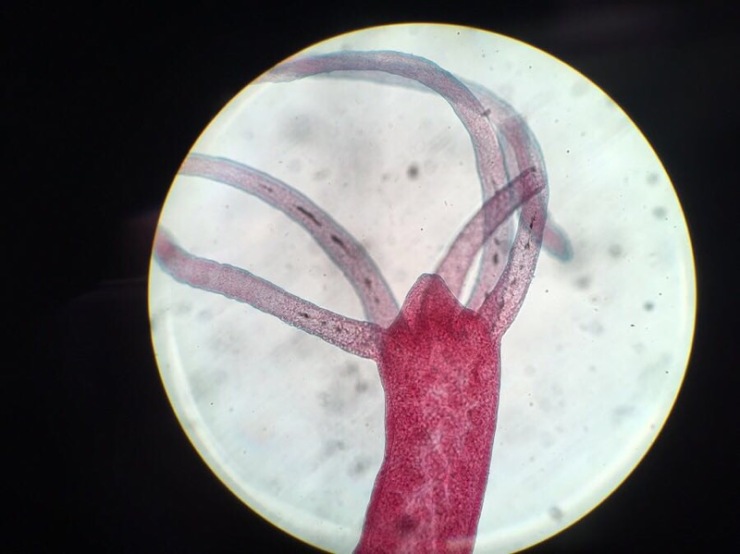41
Cnidarians are organisms found exclusively in aquatic habitats. Of the over 10,000 aquatic Cnidarian species discovered, most inhabit marine environments. Cnidarians exhibit two major body forms, polyp or medusae. Polyps consist of a body stalk with a tubular shape with a single opening and multiple tentacles that surround this opening which serves as a mouth and anus. Polyps point upward for filter-feeding. The tentacles are covered with cnidocytes (stinging cells). Cnidocytes are the most important characteristic that distinguishes organisms as belonging to the Cnidarian phylum.Polyps are sessile and remain attached to a substrate. The medusa form is most notably observed in the umbrella like form of jellies. Similar to polyps, they consist of a body with a single opening surrounded by tentacles, but the gelatinous layer is much thicker and the mouth is usually oriented towards the substrate when swimming. Many Cnidarians have the ability to switch between these two morphs over the course of their life.
Class Hydrozoa
Hydrozoans can be found in both the medusae and polyp form in equal abundance. Compared to other cnidarians hydromedusea have a thinner and more delicate mesoglae (gelatinous) layer. In the polyp phase, most hydrozoans live colonially and often have polyps that bud from other polyps. They have a shared gastrovascular (GV) cavity and are genetically identical. Since the GV cavity is shared if one polyp is actively carrying out its function, such as feeding, the product of digestion (acquisition of nutrients) can be distributed among the other polyps. Each polyp can have a different function in the colony. Although they are all genetically identical different genes are expressed to vary the function of the individuals. Individual polyps are known as zooids. Gastrozooids, gonozooids, and dactylozooids respectively function for digestion, reproduction and defense1.
Hydras are hydrozoans that are unique in several respects. Unlike almost all other hyrdrozoans, they are solitary, live in fresh water and lack a medusa phase. Like many Cnidarians, Hydras can contain endosymbiotic algae or Zooxanthellae.

Some benefits of being an individual within a colony are protection, resource sharing, and even the passing of signal impulse. If one individual is stimulated by a threat, the signal will be sent throughout the colony, initiating a retraction across the whole colony.

Class Anthozoa
Anthozoans only occur in the polyp body form. Their polyps are more complex than the other Cnidarian classes, and the colonies can grow to enormous sizes. Anthozoans include the hard corals, gorgonians, soft corals and sea anemones. Read more about corals in chapter 3.
When analyzing the “skeleton” of corals, there are distinct factors that you should pay special attention to. When they grow, coral polyps deposit CaCO3 which is constantly accumulated around the living organisms throughout the course of their life-cycles. The live polyps are housed within the calcareous cups that they secrete, these serve a skeletal function and for protection. Analyzing the ‘skeletons’ left behind after the death of these organisms, you can see how they lived and developed over time. All of the perforations that might be observed in the dead skeleton were once home to a live polyp that made up the actual live being of a coral.
The photo below depicts a living hard coral polyp with its cnidocyte-covered tentacles protruding from the calcareous cup.

Class Scyphozoa
Scyphozoans are found predominately in the medusae form, but also have polyp phases in their life cycles. The spectacular variety of jellies are in this class. Check out the Monterey Bay Aquarium’s fantastic Live Jelly Cam!

Sea Nettle (Chrysaora fuscescens) Jellyfish in captivity in the Monterey Bay Aquarium [CC BY SA 2.5]
Reference
[1] Brusca, R.C., & Brusca, G.J.(2003). Invertebrates. Sunderland, MA: Sinauer Associates, Inc.
The information of this chapter in thanks to content contributors from Jessica Comeau and Jason Charbonneau
